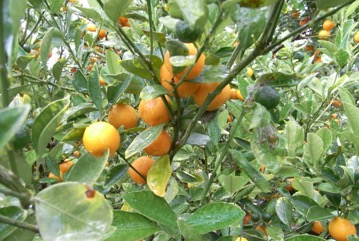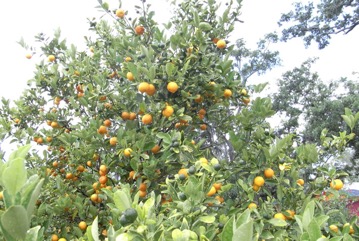Calamondin orange, Panama orange

It grows in tropical places. It is best grown in full sun but can tolerate light shade. They can tolerate some salty and seaside conditions. They have little tolerance of frost. They can grow on a range of soils. Plants need adequate fertility and sometimes need micronutrients. At MARDI.
Also known as:
Golden lime, Kalamansi, Musk lime, Scarlet lime
Synonyms
- Citrus mitis Blanco
Edible Portion
- Fruit
Where does Calamondin orange grow?
Found in: Asia, Brazil, China, Hawaii, Malaysia, North America, Pacific, Philippines, SE Asia, South America, United States
Notes: There are 20 Citrus species. Several hybrids have been formed.
Growing Calamondin orange, Panama orange
Cultivation: Plants are grown from seed. Seeds can produce 3-5 seedlings. Often seedlings produce true to type. Seeds are washed and usually germinate in 21 days. Cuttings can be used. These root easily. Plants need to be 3-6 m apart.
Edible Uses: The fruit can be eaten raw. They are acid. They are pickled, preserved and used in sauces, chutneys, and flavouring. They are also used for drinks and jellies. The whole fruit fried in coconut oil with various seasonings are eaten in curries. The preserved peel is used to flavour other foods.
Production: Plants from cuttings produce fruit is 2 years. Fruit take 8-12 months to mature. Fruit can be produced year round in warmer climates. Fruit should be picked when fully ripe.
Nutrition Info
per 100g edible portion| Edible Part | Energy (kcal) | Protein (g) | Iron (mg) | Vitamin A (ug) | Vitamin c (mg) | Zinc (mg) | % Water |
|---|---|---|---|---|---|---|---|
| - | - | - | - | - | - |
Calamondin orange, Panama orange Photos


References
Burkill, I.H., 1966, A Dictionary of the Economic Products of the Malay Peninsula. Ministry of Agriculture and Cooperatives, Kuala Lumpur, Malaysia. Vol 1 (A-H) p 580
Call, C. A., et al, 2004, Participatory Rural Appraisal in the Upland Ecosystem of Mt Malindang, Misamis Occidental, Philippines. Biodiversity Research Programme for Development in Mindanao. p 60
Elevitch, C.R.(ed.), 2006, Traditional Trees of the Pacific Islands: Their Culture, Environment and Use. Permanent Agriculture Resources, Holualoa, Hawaii. p 245
John, L., & Stevenson, V., 1979, The Complete Book of Fruit. Angus & Robertson p 92
Kiple, K.F. & Ornelas, K.C., (eds), 2000, The Cambridge World History of Food. CUP p 1743
Lyle, S., 2006, Discovering fruit and nuts. Land Links. p 123
Milow, P., et al, 2013, Malaysian species of plants with edible fruits or seeds and their evaluation. International Journal of Fruit Science. 14:1, 1-27
Staples, G.W. and Herbst, D.R., 2005, A tropical Garden Flora. Bishop Museum Press, Honolulu, Hawaii. p 501 (Drawing)
Zawiah, N. & Othaman, H., 2012, 99 Spesies Buah di FRIM. Institut Penyelidikan Perhutanan Malaysia. p 80